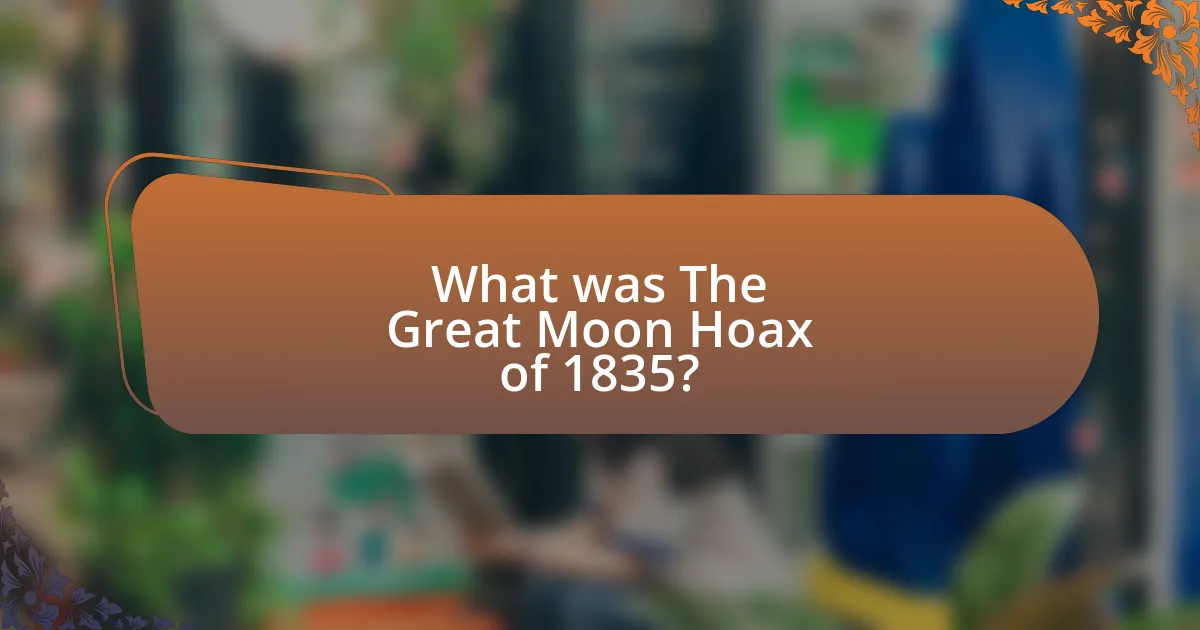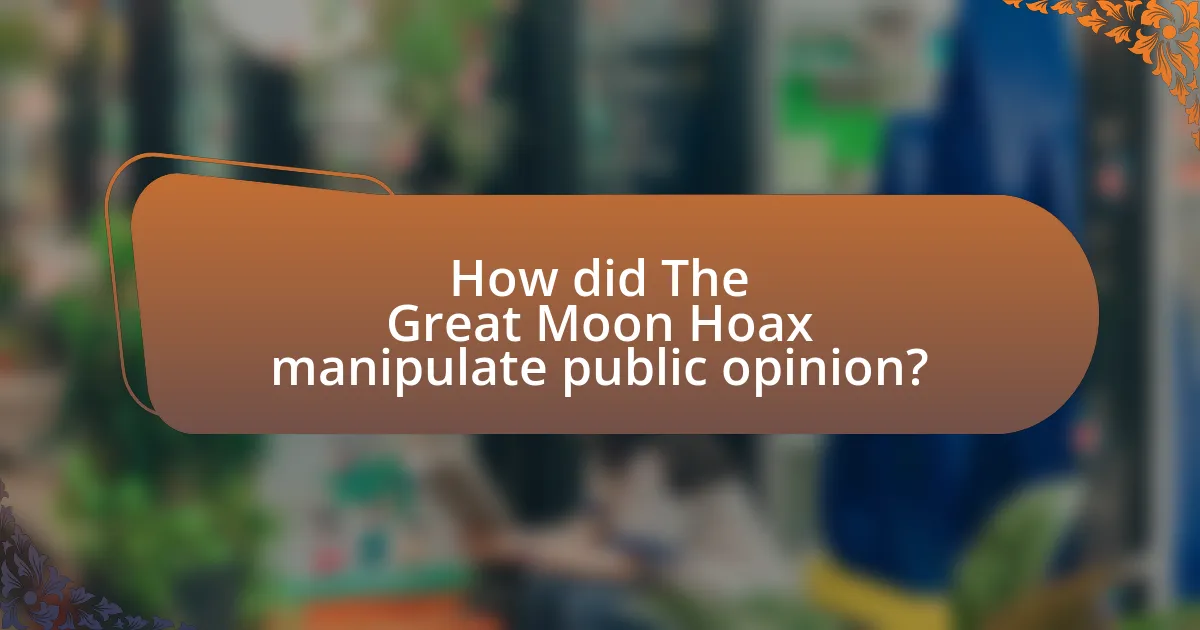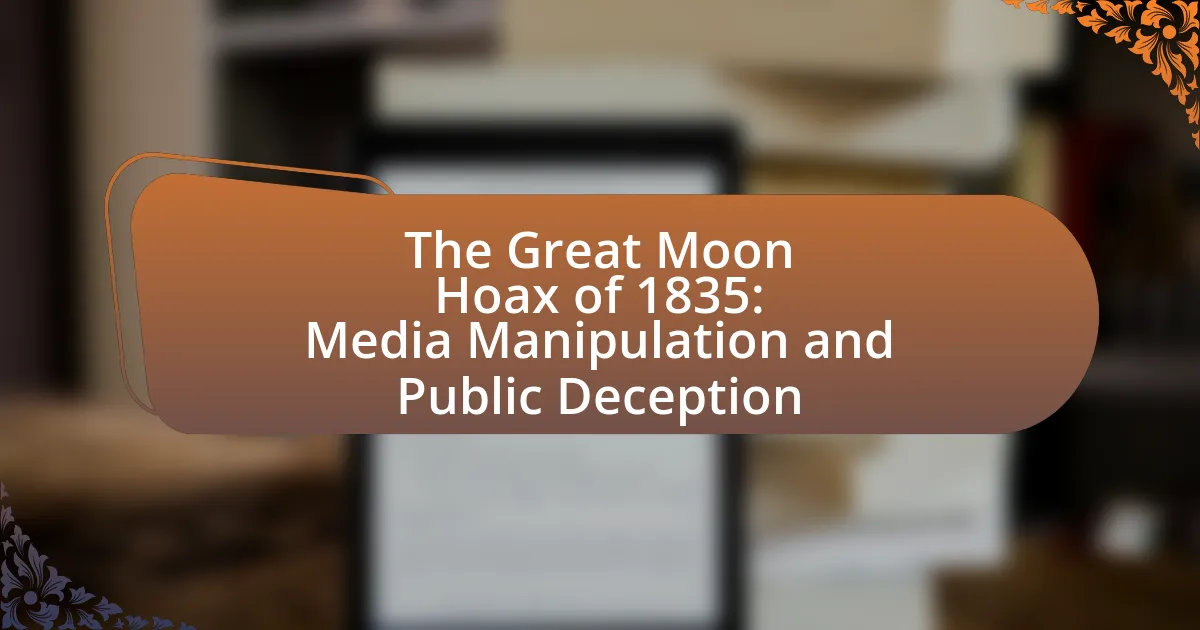The Great Moon Hoax of 1835 refers to a series of fabricated articles published in the New York Sun, claiming the discovery of life and civilization on the Moon. Authored by Richard Adams Locke and attributed to the fictional astronomer Andrew Grant, these sensational stories captivated the public and significantly increased the newspaper’s circulation. The hoax exemplifies early media manipulation and misinformation, highlighting the gullibility of audiences and the impact of sensational journalism on public perception. It serves as a critical case study in understanding the evolution of journalistic practices, the importance of media credibility, and the ongoing challenges of misinformation in contemporary society.

What was The Great Moon Hoax of 1835?
The Great Moon Hoax of 1835 was a series of fabricated articles published in the New York Sun, claiming the discovery of life and civilization on the Moon. The articles, attributed to the fictional astronomer Andrew Grant, described fantastical creatures and landscapes, capturing public imagination and leading to widespread belief in the hoax. The New York Sun’s circulation increased significantly as a result, demonstrating the power of media manipulation and public deception in the 19th century.
How did The Great Moon Hoax come to be?
The Great Moon Hoax originated from a series of articles published in the New York Sun in 1835, which falsely claimed the discovery of life and civilization on the Moon. The newspaper’s editor, Richard Adams Locke, fabricated these stories to attract readership and increase sales, leveraging the public’s fascination with astronomy and exploration. The articles described fantastical creatures and landscapes, capturing the imagination of the audience and leading to widespread belief in the hoax. The sensational nature of the claims and the credibility of the publication contributed to the hoax’s success, demonstrating the power of media manipulation in shaping public perception.
What were the key events leading up to the publication?
The key events leading up to the publication of “The Great Moon Hoax” in 1835 included the rise of sensational journalism and the publication of a series of articles in the New York Sun. The New York Sun, under the editorship of Richard Adams Locke, aimed to increase circulation and attract readers through captivating stories. In August 1835, Locke published a series of articles claiming the discovery of life on the Moon, purportedly based on the observations of the astronomer Andrew Grant. This was a strategic move to capitalize on the public’s fascination with astronomy and exploration, particularly following the advancements in telescopic technology. The articles generated immense public interest and debate, showcasing the effectiveness of media manipulation in shaping public perception.
Who were the main figures involved in the hoax?
The main figures involved in the Great Moon Hoax of 1835 were Richard Adams Locke, who was the author of the articles, and the New York Sun, the newspaper that published them. Locke wrote a series of six articles claiming the discovery of life on the Moon, which were presented as scientific reports. The New York Sun, under the editorship of Benjamin H. Day, facilitated the widespread dissemination of these fabricated stories, leading to public fascination and belief in the hoax.
Why is The Great Moon Hoax significant in media history?
The Great Moon Hoax is significant in media history because it exemplifies early instances of sensationalism and misinformation in journalism. Published in 1835 by The Sun newspaper in New York, the series of articles falsely claimed the discovery of life on the Moon, capturing public imagination and demonstrating the power of the press to influence public perception. This event highlighted the potential for media to manipulate facts for entertainment and profit, setting a precedent for future media practices that prioritize sensational stories over factual accuracy. The hoax ultimately contributed to discussions about journalistic ethics and the responsibility of the media, making it a pivotal moment in the evolution of news reporting.
What impact did it have on public perception of the media?
The Great Moon Hoax of 1835 significantly altered public perception of the media by fostering skepticism regarding journalistic credibility. The fabricated articles published in The Sun newspaper, which claimed the discovery of life on the Moon, led to widespread public fascination but also raised questions about the reliability of news sources. This incident highlighted the potential for media manipulation, prompting audiences to critically evaluate the authenticity of sensational stories. As a result, it contributed to a lasting wariness towards media claims, influencing how future news was consumed and scrutinized.
How did it influence future journalistic practices?
The Great Moon Hoax of 1835 significantly influenced future journalistic practices by highlighting the potential for sensationalism and fabrication in news reporting. This event demonstrated that newspapers could manipulate public perception through fabricated stories, leading to a greater emphasis on fact-checking and journalistic integrity in subsequent reporting. The hoax prompted the establishment of ethical standards and guidelines within journalism, as seen in the later development of codes of ethics by organizations such as the American Society of News Editors in the 1920s, which aimed to promote accuracy and accountability in news reporting.
What were the main themes of The Great Moon Hoax?
The main themes of The Great Moon Hoax include media manipulation, public deception, and the intersection of science and sensationalism. The hoax, published in 1835, featured fabricated articles claiming the discovery of life on the Moon, which illustrated how media could be used to captivate and mislead the public. This event highlighted the gullibility of audiences and the potential for journalism to prioritize sensational stories over factual reporting, as evidenced by the widespread belief in the hoax despite its lack of credible evidence.
How did the hoax reflect societal beliefs about science and exploration?
The Great Moon Hoax of 1835 reflected societal beliefs about science and exploration by showcasing the public’s fascination with celestial discoveries and the gullibility towards sensationalized information. During this period, the excitement surrounding scientific advancements, such as the telescope’s ability to reveal distant worlds, led people to eagerly accept extraordinary claims without skepticism. The hoax, published in The Sun newspaper, described fantastical life forms on the Moon, tapping into the era’s romanticism about exploration and the unknown. This incident highlighted how the media could manipulate public perception, revealing a societal tendency to prioritize entertainment over critical analysis of scientific claims.
What role did imagination play in the narratives presented?
Imagination played a crucial role in the narratives of “The Great Moon Hoax of 1835” by enabling the creation of fantastical stories that captivated the public’s interest. The narratives, which described incredible lunar discoveries and life forms, were crafted to evoke wonder and curiosity, effectively manipulating public perception. This manipulation was evident as the stories were presented as factual reports, leading many to believe in the existence of extraterrestrial life and advanced civilizations on the Moon. The success of these narratives relied heavily on the imaginative elements that blurred the lines between reality and fiction, demonstrating how imagination can influence societal beliefs and media consumption.

How did The Great Moon Hoax manipulate public opinion?
The Great Moon Hoax manipulated public opinion by publishing a series of fabricated articles in the New York Sun that claimed the discovery of life on the Moon. These articles, attributed to the fictional astronomer Andrew Grant, described fantastical creatures and landscapes, capturing the imagination of the public. The sensational nature of the stories led to widespread fascination and belief in the existence of extraterrestrial life, demonstrating the power of media to shape perceptions and influence societal views on science and exploration during the 19th century. The hoax ultimately highlighted the gullibility of the audience and the potential for media to distort reality for entertainment and profit.
What techniques were used to create the hoax?
The techniques used to create the Great Moon Hoax of 1835 included fabricated articles, sensationalism, and the use of authoritative sources. The Sun newspaper published a series of six articles claiming the discovery of life on the Moon, which were attributed to the respected astronomer Andrew Grant. This tactic leveraged the credibility of a known figure to enhance the believability of the hoax. Sensational descriptions of lunar creatures and landscapes were employed to captivate readers and provoke public interest, leading to widespread belief in the fabricated stories. The combination of these techniques effectively manipulated public perception and demonstrated the power of media in shaping narratives.
How did sensationalism contribute to the hoax’s success?
Sensationalism significantly contributed to the success of the Great Moon Hoax of 1835 by amplifying public interest and engagement. The New York Sun, which published the hoax, utilized exaggerated claims about life on the moon, including fantastical descriptions of lunar inhabitants and landscapes, which captivated readers’ imaginations. This approach not only drew attention but also encouraged widespread discussion and speculation, leading to increased newspaper sales. The sensational nature of the articles played a crucial role in creating a narrative that was both entertaining and believable, ultimately resulting in the hoax being accepted by many as truth.
What role did illustrations play in the public’s belief?
Illustrations played a crucial role in shaping the public’s belief during the Great Moon Hoax of 1835 by visually reinforcing the sensational claims made in the articles. The illustrations depicted fantastical scenes of life on the moon, including creatures and landscapes that captivated readers’ imaginations. This visual representation made the outlandish stories more credible and engaging, leading to widespread acceptance among the public. Historical accounts indicate that the combination of vivid imagery and persuasive writing significantly influenced public perception, as many readers were more likely to believe in the moon’s inhabitants due to the compelling illustrations accompanying the text.
Why did the public fall for The Great Moon Hoax?
The public fell for The Great Moon Hoax due to a combination of sensationalism in media, the credibility of the publication, and the prevailing fascination with astronomy. The Sun newspaper, which published the hoax, was a widely read and respected outlet, lending authority to the fabricated stories about life on the moon. Additionally, the early 19th century saw a surge in interest in celestial phenomena, making the extravagant claims about lunar inhabitants particularly captivating. The combination of a reputable source and a public eager for sensational news created an environment ripe for deception.
What were the prevailing attitudes towards science and exploration in the 1830s?
In the 1830s, prevailing attitudes towards science and exploration were characterized by a mix of enthusiasm and skepticism. The period saw a growing public interest in scientific discoveries and exploration, fueled by advancements in technology and the publication of sensational accounts, such as those in the Great Moon Hoax of 1835, which illustrated the public’s fascination with the unknown. However, this enthusiasm was tempered by skepticism regarding the authenticity of scientific claims, as many people questioned the credibility of sources and the motives behind sensationalized reports. This duality reflected a broader societal struggle to reconcile emerging scientific knowledge with traditional beliefs and the desire for empirical evidence.
How did the media’s credibility affect public trust?
The media’s credibility significantly impacted public trust by shaping perceptions of truth and reliability in information dissemination. During the Great Moon Hoax of 1835, the publication of fabricated articles in the New York Sun led to widespread belief in the existence of life on the moon, demonstrating how sensational journalism could manipulate public opinion. This incident highlighted that when media outlets prioritize sensationalism over factual reporting, they can erode trust, as audiences may become skeptical of future claims. The aftermath of the hoax resulted in a long-lasting wariness towards media sources, illustrating that credibility is essential for maintaining public trust in journalism.

What lessons can be learned from The Great Moon Hoax?
The Great Moon Hoax teaches critical lessons about media manipulation and the susceptibility of the public to sensationalism. The hoax, published in 1835 by the New York Sun, presented fabricated stories about life on the moon, demonstrating how easily misinformation can spread when presented as credible news. This incident highlights the importance of skepticism and critical thinking in evaluating sources of information, as well as the responsibility of media outlets to verify facts before publication. The widespread belief in the hoax illustrates the potential consequences of unchecked journalistic practices, emphasizing the need for ethical standards in reporting to prevent public deception.
How can modern media avoid similar deceptions?
Modern media can avoid similar deceptions by implementing rigorous fact-checking protocols and promoting transparency in sourcing information. Establishing a culture of accountability within news organizations ensures that journalists verify claims through multiple credible sources before publication. For instance, the rise of misinformation during events like the COVID-19 pandemic highlighted the necessity for accurate reporting, as studies showed that false information spread rapidly, leading to public confusion and mistrust. By prioritizing accuracy and transparency, modern media can build credibility and prevent the recurrence of deceptive practices similar to those seen in the Great Moon Hoax of 1835.
What practices can enhance media literacy among the public?
Practices that can enhance media literacy among the public include critical thinking education, fact-checking initiatives, and promoting diverse media consumption. Critical thinking education equips individuals with the skills to analyze and evaluate information critically, which is essential in discerning credible sources from misinformation. Fact-checking initiatives, such as those provided by organizations like Snopes and FactCheck.org, help individuals verify claims and understand the context behind news stories. Promoting diverse media consumption encourages exposure to various perspectives, reducing the risk of echo chambers and fostering a more comprehensive understanding of issues. These practices are supported by research indicating that media literacy education significantly improves individuals’ ability to navigate complex media landscapes and recognize bias, as demonstrated in studies conducted by the National Association for Media Literacy Education.
How can fact-checking improve journalistic integrity?
Fact-checking can significantly improve journalistic integrity by ensuring that information disseminated to the public is accurate and reliable. By rigorously verifying facts before publication, journalists can prevent the spread of misinformation, which was notably exemplified during the Great Moon Hoax of 1835, where fabricated stories misled the public. This commitment to accuracy fosters trust between journalists and their audience, as evidenced by studies showing that audiences are more likely to trust media outlets that prioritize fact-checking. Furthermore, consistent fact-checking practices can enhance accountability within journalism, as reporters are held to higher standards of truthfulness, ultimately leading to a more informed society.
What are the implications of The Great Moon Hoax for today’s society?
The implications of The Great Moon Hoax for today’s society include heightened skepticism towards media and the recognition of the potential for misinformation to shape public perception. This historical event demonstrated how sensational journalism can manipulate public opinion, leading to a lasting wariness of media sources. The hoax, published by The Sun newspaper in 1835, illustrated the power of fabricated narratives to capture the imagination and influence societal beliefs, a phenomenon that is increasingly relevant in the age of digital media and social networks, where misinformation can spread rapidly and widely.
How does the hoax relate to current issues of misinformation?
The Great Moon Hoax of 1835 exemplifies how misinformation can spread rapidly through media channels, paralleling current issues of misinformation in the digital age. This hoax, published in the New York Sun, misled the public with fabricated stories about life on the moon, demonstrating the power of sensationalism and the lack of fact-checking in journalism. Today, similar tactics are employed through social media platforms, where false information can go viral, often without verification, leading to widespread public deception. The hoax serves as a historical case study, highlighting the ongoing challenges of discerning truth in an era where misinformation can easily manipulate public perception and opinion.
What strategies can individuals use to critically evaluate media sources?
Individuals can critically evaluate media sources by employing strategies such as checking the credibility of the source, analyzing the evidence presented, and cross-referencing information with reputable outlets. Credibility can be assessed by examining the author’s qualifications, the publication’s reputation, and the presence of editorial standards. Analyzing evidence involves looking for citations, data, and expert opinions that support claims made in the media. Cross-referencing information with reputable outlets helps to verify facts and identify potential biases or misinformation. These strategies are essential in discerning the reliability of media, especially in the context of historical events like the Great Moon Hoax of 1835, where sensationalism led to widespread public deception.
